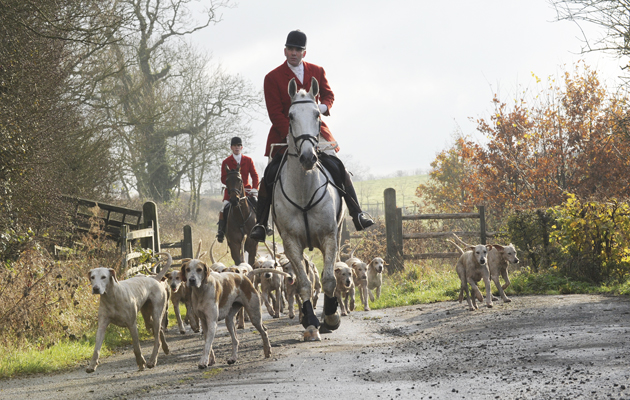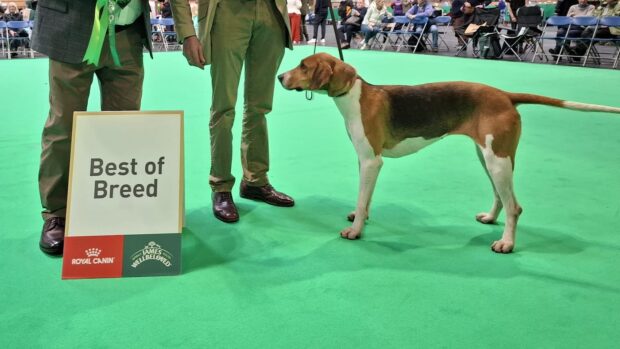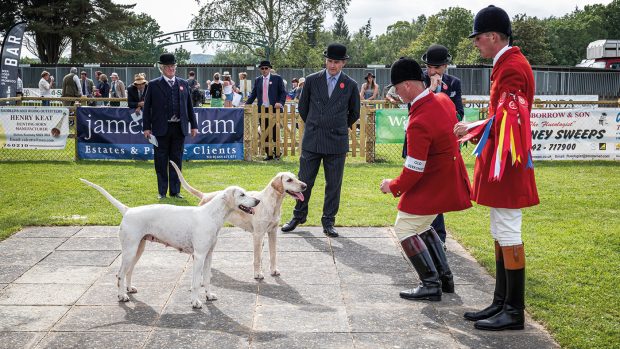The harrier is a medium-sized hound breed known for its endurance, agility, and strong scenting ability. Originating in England, the harrier is a scent hound developed for hunting hares and foxes, in packs. It is very similar to the English foxhound but is distinguishable by its shorter stature, though they share common ancestry. The harrier stands between the taller foxhound and the smaller beagle – and is the oldest breed of the three.
The breed’s history can be traced back at least to the 13th century and its name reflects what it was originally bred to do, which is to hunt hares. It was also known as the “hare hound”. The harrier was bred to be followed on foot but in the 19th century it was crossed with the foxhound to produce a faster, lighter hound, which could also be followed on horse. The two principal types of harrier in the UK are the Studbook Harrier and the West Country Harrier. The latter is lighter in both colouring and type.
Physically, the harrier is well-balanced with a moderately long, straight back, a deep chest, and a strong, muscled hindquarters. Its head is broad with a well-defined stop, and it features large, hazel eyes conveying a friendly and alert expression. The ears are set low, hanging down and slightly forward, while the tail is carried high and may have a slight curve.
Harriers are prey-driven hounds with a strong hunting instinct and excellent nose. They have stacks of stamina, thanks to being bred over centuries to chase prey for hours, over many miles and varied terrain.

Harrier dog breed: fact file
Kennel Club breed group: hound
Size: medium/large
Daily exercise: more than two hours
Coat: short, shedding
Colours: badger pied, black/tan, lemon/white, red/white, tri-colour, white. Eye colour harmonises with coat colour
Lifespan: more than 12 years
Bark: loud, prolonged (correctly termed “voice”)
History: harrier breeding goes back to medieval times in England, as there are detailed records of individual packs dating from 1260 to the current day. They are generally a pack dog, and were originally owned only by hunts. The Association of Masters of Harriers and Beagles was formed in 1891, with a studbook which records some 107 registered harrier packs.
Distinctive features: smooth-coated, build for endurance and stamina but without coarseness. Well-balanced, strong and compact physique.
Temperament: friendly, lively, never nervous or aggressive
Things to consider: while harriers are not typically domestic pets as they thrive on working in a pack, you can get in touch with your local harrier pack if you have the time, patience and space to offer your services as a puppy walker.
Training: not a natural domestic pet, as these hounds have been bred and reared to work in packs, where they are brilliantly trainable.

Wisdom Panel DNA collection kit | Amazon.co.uk
Find out what breed your dog is with this kit that gives you everything you need to collect your dogs DNA and send it off. Includes a pre-paid envelope if you’re in the UK.
You may also enjoy reading…

Did you know: a hound is a dog, but not all dogs are hounds

All about the foxhound

All about the deerhound

25 fabulous facts about dogs

A beginner’s guide to trail hunting: all your key questions answered

Subscribe to Horse & Hound magazine today – and enjoy unlimited website access all year round
Horse & Hound magazine, out every Thursday, is packed with all the latest news and reports, as well as interviews, specials, nostalgia, vet and training advice. Find how you can enjoy the magazine delivered to your door every week, plus options to upgrade your subscription to access our online service that brings you breaking news and reports as well as other benefits.




